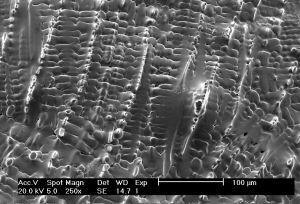
Effective composites/Lasagna noodles
stiff direction
cross-section of ruffled, compliant part of graphite ribbon (mimics matrix)
cross-section of central, stiff part of graphite ribbon (mimics carbon fiber)
one "noodle" within effective composite crystal
In principle, this kind of material can be synthesized with a low density of graphene edges. Raman spectroscopy data show that the origami variant of curved kish routinely has a low edge density, much like HOPG. Sufficiently low edge density will make highly oriented, high strength graphite gas-tight and useful for high pressure hydrogen storage tanks. Reduced edge density will also make this effective composite oxidation resistant. Wavy graphite will still be vulnerable to oxidation at the defects of intrinsic curvature. For demanding applications, these graphene defects may be replaced with hexagonal boron nitride by a substitution reaction[16,17].
The SEM micrographs show we can make objects somewhat similar to this "lasagna noodle" structure, already. This cactus-like structure is easy to produce, appearing spontaneously when thin graphene deposits are swiftly cooled. For more careful control of the shape of curved graphite materials, a general-purpose electrostatic patterning technique is called for.